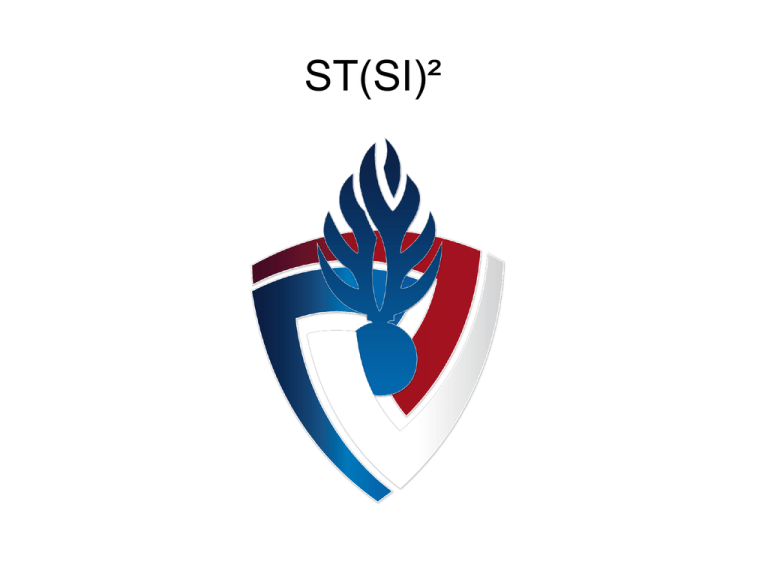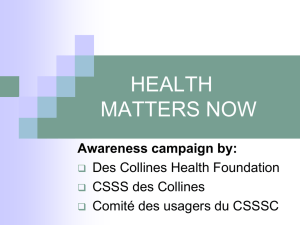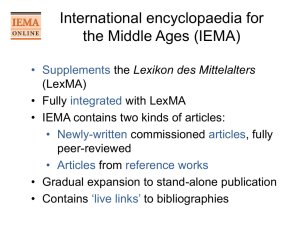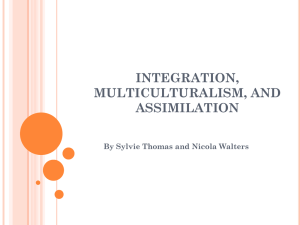ST(SI)² - Open Mobile Alliance
advertisement

ST(SI)² Next Generation Networks PMR Status in France ---Possible way forward towards a global standard Emmanuelle Villebrun, French Ministry of Interior 3GPP-ETSI-OMA workshop Montreal, 26-27 August 2014 Service des Technologies et des Systèmes d’Information de la Sécurité Intérieure Critical Communications Infrastructures in France Public Safety : 2 national TETRAPOL networks for voice communications and low speed data Infrastructure Nationale Partageable des Transmissions (INPT) • Mainly police, fire brigades + other users • 400MHz ~1500 sites for national coverage • TDM backbone RUBIS • Gendarmerie, Marine nationale • 80MHz ~500 sites + 400MHz extensions • IP backbone Critical Business communications TETRA networks by SNCF, RATP, Aéroports de Paris, polices municipales Develop common infrastructure for the future for as many users as we can Service des Technologies et des Systèmes d’Information de la Sécurité Intérieure New services to improve security and its efficiency Service des Technologies et des Systèmes d’Information de la Sécurité Intérieure General strategy Separate: Data transport Service management Subscriber management One contract split In three or more Not to forget : Proximity Services, Isolated/fall back modes, resiliency Service des Technologies et des Systèmes d’Information de la Sécurité Intérieure Consequences on infrastructure (about IMS…) • We need te be able not to rely on commercial infrastructure • Some users will always need their own infrastraucture • • • • Public safety, militaries, critical utilities Some will need to ensure a minimum of independance with self deployable networks • In case of catastrophy or big event • When life is at stake (public will not accept rescue being late because of telecommunication failure) Private and public networks will be used in parallel like today Commercial technology reuse • Only what we need (not all commercial services 3GPP could imagine!) • Being able to have a dedicated independant infrastrucure • Infrastructure of different size without all commercial functions • • Control room in a truck, mobile control room (not full IMS!!!) With full interoperability with commercial networks for critical communications services! Service des Technologies et des Systèmes d’Information de la Sécurité Intérieure Need for a standard as global as possible • New focus on critical communications specific questions • Professionnal services (group communications, video communications) • Open interfaces to ensure the ability of any organization to develop professionnal softwares (Interfaces with control rooms) • Priority management between different organizations depending multiple factors including the event type • New opportunities for companies to adress just a part of the market • with an open environment • with any useful technology (Machine to Machine, professionnal dedicated softwares etc…) Innovation and competition are essential for the next generation public safety telecommunication infrastructures, users have to organize the market through standards development Service des Technologies et des Systèmes d’Information de la Sécurité Intérieure Key functions needed • Transport functions • PROSE, IOPS, GCSE • Application functions • MINIMUM FIRST SET OF SERVICES: Group communications for any kind of data (text, video, files) in order to instantaneously share data between people on the field • Applications for information management (datamining, video/sensor information management) • In the control room • In the future could be done on the field also (small control rooms unit in a truck) • Cost management needs • Avoid to manage multiple networks that is why we also need voice…. • With no data application, users have no reason to buy a LTE network since classical data applications are too limited Service des Technologies et des Systèmes d’Information de la Sécurité Intérieure Standardization on going works • Standards different streams • OMA and ETSI for application part • 3GPP for transport and voice MCPTT • ETSI standard is at « stage 2 » with a defined architecture • Generic group communication able to manage any kind of data • User requirements light procedure • OMA standard for Public Safety begins with user requirements • Will be aligned with release 13, other functions such as location management • Push OMA and ETSI to liaise with each other 9 month to organize a conference call (seems there was some resistance!)… • 3GPP Voice only in release 13 • User requirements entirely redone for voice without data enhancement • No one meets our needs… Service des Technologies et des Systèmes d’Information de la Sécurité Intérieure Work item synchronization 3GPP MCPTT ETSI TCCE • • • • • • • • • • • • User Id @SIP Organization management Group management Profile management Application priority management Generic MCPTT Dispatcher data management Operationnal event logging Video surveillance Data mining Remote sensor operations Distant operations (medical, rescue, expertise) Already existing IMS interfaces + new functions PROSE GCSE IMSI RAN resources for users - Radio bearer - Wired transport in Control if private network RAN - MBMS Priority management (global parameters) - Access control - Radio bearer priority Negociation if public or and preemption shared network Service des Technologies et des Systèmes d’Information de la Sécurité Intérieure Road map for application part 3GPP R 13 Requirements 3GPP R 14 Architecture Protocols Requirements ETSI TETRA/TETRAPOL/P25 protocols Enhancements for data Other services 3GPP Video Voice without use cases SMS Maps… Service des Technologies et des Systèmes d’Information de la Sécurité Intérieure Way forward • • • • • Time management: PMR standards were developped over 20 years • Conclusion in ETSI : redoing all would take to much time • What 3GPP will do? We have completely redone requirements, do the same for technical work? User organizations are able to buy their own proprietary solution • Like in TETRA and TETRAPOL they will buy the solution before interoperability testing • Interoperability will then be expensive or impossible We need a first version standard as quick as possible • With new data services to avoid proprietary solutions • With voice in order to avoid maintaining several networks A world wide standard is really suitable but… A regional/local such as ETSI remains a fallback solution if world wide is not possible • Manage operational constraints at borders with big political impact Service des Technologies et des Systèmes d’Information de la Sécurité Intérieure Proposed way forward (may be last chance for a global standard!) • There is a remaining way forward • Take ETSI work as a basis • Generic Group communication taken into account as soon as the architecture work on application part begins • • • Requirements shall be put in early release 14 • Release 13 that takes into account generic group communication in advance Start the work on other applications in SA1 priority management issue between Critical Communications and commercial world But… way of working has to be really improved! • Being generic, managing all kind of data at the same time • Work items synchronization • Create a new dedicated group to avoid bottlenecks and to be able to go faster • Avoid time consuming liaisons between different groups in 3GPP • ability to have one or more subgroups (one for security at application level, discussion forum for user requirements,…) Service des Technologies et des Systèmes d’Information de la Sécurité Intérieure











